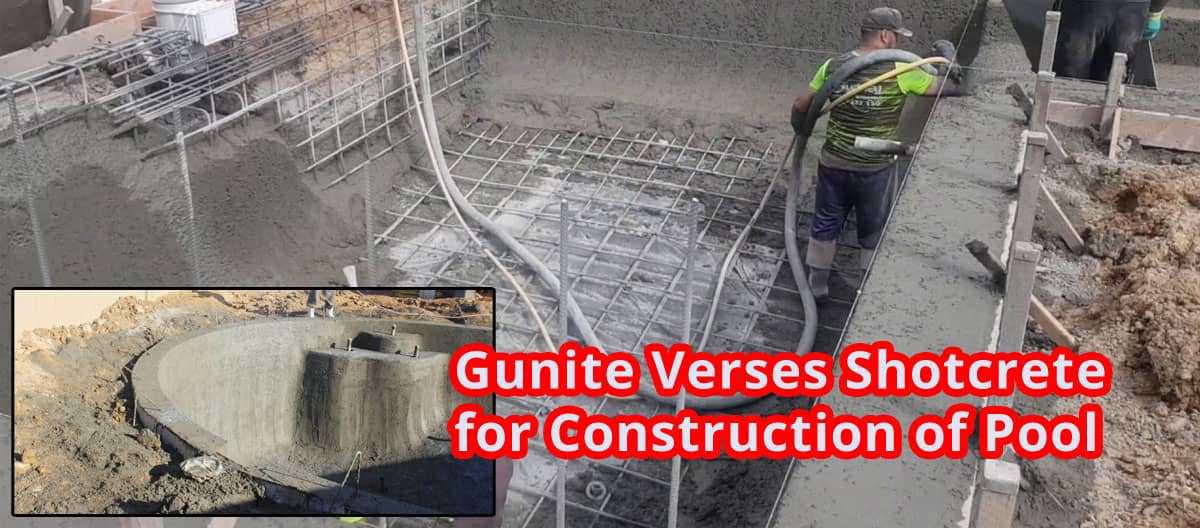Gunite Verses Shotcrete for Construction of Pool

Shotcrete and Guniting both serve the same purpose, but their application Technique is different. The construction techniques like shotcreting and Guniting are among the most common and widely used. Both techniques have different advantages and disadvantages. Guniting and shotcreting are two different Techniques. Among the many applications of spray, concrete is building tunnels and underground structures, stabilizing slopes, repairing structures, and constructing swimming pools.
These materials can build parking structures and retaining walls. But let's stick to today's topic: pools.
Construction Technique of Concrete Pool
The construction Technique is essentially the same, no matter whether you choose Gunite or Shotcrete. You will need to prepare the ground for your pool by measuring and excavating it. Next, you will install the plumbing. Install the steel rebar tied in place and reinforce the cage. It's time to spray the concrete after the rebar encases in concrete. At this point, you have the option of using Gunite or Shotcrete.
Following the completion of the pool's shell, the concrete should cure, and the pool will be ready to use. The tile can install after curing the concrete. The next step is to build the patio. The only thing left is to apply the finish and enjoy your new pool.
Shotcrete Technique
You're working with a wet concrete mix when you're doing Shotcrete. To begin, thoroughly mix the concrete. Trucks deliver wet concrete to the Shotcrete site. The Shotcrete Techniques uses compressed air in the same way as the Gunite dry-mix Technique. Spraying concrete at such a high speed causes it to bond to itself when it applies.
Benefits of Shotcrete
- As the concrete comes already mixed, it doesn't require as much skill from the crew.
- Gunite is a slower Technique than Shotcrete.
- Productivity increases.
- No need for water.
- Reduces equipment requirements.
- The materials are easy to find in most places.
- Concrete can be injected with specialized admixtures more easily.
Drawbacks of Shotcrete
- A clogged hose can be difficult for crews and the property to clear, which can cause danger.
- Pumping may be easier if you add water.
- It is difficult for the crew to use the heavy hoses due to their weight.
- The application cannot be started and stopped, as this would create weak points in the concrete.
Gunite Technique
A Gunite application requires dry premixed material to load into the equipment. To fill a pool, contractors use compressed air to shoot the dry concrete through a hose to a nozzle, where they add water. A high-velocity spray then ejects the wet mixture onto the pool surface. The nozzle-man adjusts water levels accordingly. Compression occurs as you apply the concrete To achieve the desired consistency.
Benefits of Gunite
- Shotcrete is more expensive than Gunite.
- Gunite enables you to start and stop an application without causing any vulnerability.
- The product is extremely strong and shrinks little.
- Concrete that is wet can be walked on without causing any damage.
- Shotcrete can be difficult to clean up compared to Gunite.
- There is a lighter and more convenient hose.
- Concrete sprayed from the nozzle will be fresh because water is added to the nozzle.
Drawbacks of Gunite
- Crews with more experience are needed for igniting.
- Clogged hoses can occur when the concrete is dry.
- In addition to producing a great deal of overspray and rebound, Gunite can be a very messy material.
- It takes a lot of work to maintain the equipment.
- Shotcrete has a lower production rate.
Final Thoughts
Wet cement sprayed onto your pool's walls and floor with Gunite as well as Shotcrete. Gunite, on the other hand, sprays water onto dry concrete as it dries. Adding water to Shotcrete is not necessary since it starts with wet concrete. Both Shotcrete and Gunite have their pros and cons. A properly constructed swimming pool will be watertight, durable, and of high quality. It is up to you to decide depending on the construction situation of building a water pool.
